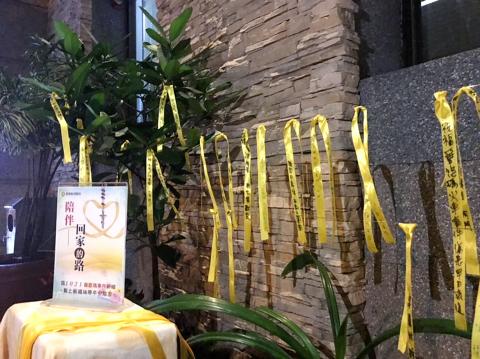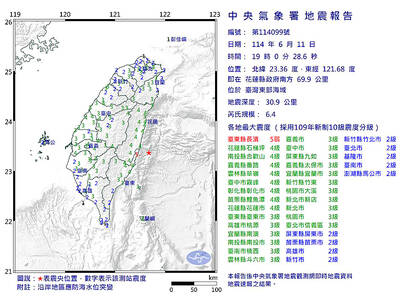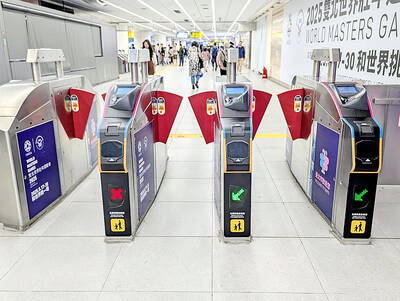While the Taiwan Railways Administration (TRA) yesterday attributed Sunday’s deadly train derailment to the driver, the Executive Yuan said that an investigation has not turned up evidence that the accident was due to human error.
The driver operating the Puyuma Express train that derailed in Yilan County turned off the automatic train protection (ATP) system without informing the dispatch and distribution office, the TRA said.
TRA operations were under scrutiny yesterday at the legislature’s Transportation Committee in the wake of the accident that killed 18 passengers and injured 190 people.

Photo copied by Chiang Chih-hsiung, Taipei Times
Lawmakers were particularly concerned about why the ATP system, which should be activated when a driver exceeds the speed limit, was turned off by the driver, surnamed Yu (尤).
Yu was supposed to operate the train at 75kph with a functioning ATP when he was driving through a curve near the Sinma Train Station (新馬), Deputy Minister of Transportation and Communications Wang Kwo-tsai (王國材) said.
However, Yu was found to have driven through the section at 140kph with a turned-off ATP, he said.
TRA Director-General Jason Lu (鹿潔身) said that the ATP was already turned off after the train passed through Dasi Train Station (大溪).
Although Yu did tell the agency that he was having problems with the air compressors, the train was operating at normal speed and he had no problem pulling in at Yilan and Luodong (羅東) stations.
However, the train began accelerating to 140kph after it passed Luodong Station, Lu said.
Train communication records also showed that Yu did not tell the dispatch and distribution office that he had turned off the ATP, Lu said.
Standard operating procedures state that drivers can turn off the ATPs only when they are out of order, Lu said.
If the driver wants to turn off a malfunctioning ATP, they must inform the dispatch and distribution office and must try to turn it on again when the train reaches the next station.
Should the driver fail to reactivate the ATP, the TRA will either have to change trains or send an assistant to help the driver handle any possible problem along the route.
Although the TRA acquired a remote surveillance system in 2010 to monitor if ATPs on trains are working properly, Lu said that this not apply to Puyuma Express trains.
“The surveillance system cannot tell if the ATPs were shut down because they were out of order or were turned off by drivers, which has caused troubles for dispatch and distribution officers,” Lu said. “When the Puyuma Express was launched in 2012, we decided not to use the surveillance system on Puyuma Express trains. We are asking the manufacturers to enhance the functions of the remote surveillance system.”
TRA Deputy Director-General Du Wei (杜微) said that You reported problems with the air-conditioning system in addition to the air compressors, but the communications records did not show that he had told the dispatch and distribution office about shutting down the ATP.
The TRA reiterated that the ATP on the derailed Puyuma Express train was working normally before it was turned off.
Local media reported that You told prosecutors that he had turned off the ATP when the train reached Dasi Train Station and that he did not try to reactivate it at the next stop.
However, You said that he had told the dispatch and distribution office about turning off the ATP.
The TRA resumed two-way operation at the section between Dongshan Train Station (冬山) and Sinma at 5:54am yesterday.
The speed limit at this section has been lowered from 75kph to 40 kph for now, it said.
Meanwhile, the Executive Yuan task force established to investigate the train accident yesterday dismissed media reports that human error was the main cause of the tragedy.
The task force is still going through evidence and examining the train and its records and has yet to reach a conclusion, task force spokesman, Bureau of High Speed Rail Director-General Allen Hu (胡湘麟), said in a press release.
“We have not yet made the conclusion or the assumption that the primary cause of the accident is human negligence,” Hu said, urging the media to stop speculating.
The task force is trying to ascertain why the train’s ATP was turned off and why it was traveling at a high speed, while gathering information about railroads, the train’s maintenance, travel and communication records, as well as images taken at the scene of the accident, Hu said.
A team of experts will process the evidence and find out the real cause of the accident, so that the TRA can make necessary improvement to avoid similar occurrences in the future, Hu said.
Additional reporting by CNA

A magnitude 6.4 earthquake struck off the coast of Hualien County in eastern Taiwan at 7pm yesterday, the Central Weather Administration (CWA) said. The epicenter of the temblor was at sea, about 69.9km south of Hualien County Hall, at a depth of 30.9km, it said. There were no immediate reports of damage resulting from the quake. The earthquake’s intensity, which gauges the actual effect of a temblor, was highest in Taitung County’s Changbin Township (長濱), where it measured 5 on Taiwan’s seven-tier intensity scale. The quake also measured an intensity of 4 in Hualien, Nantou, Chiayi, Yunlin, Changhua and Miaoli counties, as well as

Credit departments of farmers’ and fishers’ associations blocked a total of more than NT$180 million (US$6.01 million) from being lost to scams last year, National Police Agency (NPA) data showed. The Agricultural Finance Agency (AFA) said last week that staff of farmers’ and fishers’ associations’ credit departments are required to implement fraud prevention measures when they serve clients at the counter. They would ask clients about personal financial management activities whenever they suspect there might be a fraud situation, and would immediately report the incident to local authorities, which would send police officers to the site to help, it said. NPA data showed

ENERGY RESILIENCE: Although Alaska is open for investments, Taiwan is sourcing its gas from the Middle East, and the sea routes carry risks, Ho Cheng-hui said US government officials’ high-profile reception of a Taiwanese representative at the Alaska Sustainable Energy Conference indicated the emergence of an Indo-Pacific energy resilience alliance, an academic said. Presidential Office Secretary-General Pan Men-an (潘孟安) attended the conference in Alaska on Thursday last week at the invitation of the US government. Pan visited oil and gas facilities with senior US officials, including US Secretary of the Interior Doug Burgum, US Secretary of Energy Chris Wright, Alaska Governor Mike Dunleavy and US Senator Daniel Sullivan. Pan attending the conference on behalf of President William Lai (賴清德) shows a significant elevation in diplomatic representation,

The Taipei MRT is to begin accepting mobile payment services in the fall, Taipei Rapid Transit Corp said on Saturday. When the company finishes the installation of new payment units at ticketing gates in October, MRT passengers can use credit cards, Apple Pay, Google Pay and Samsung Pay, the operator said. In addition, the MRT would also provide QR payment codes — which would be compatible with Line Pay, Jkopay, iPass Money, PXPay Plus, EasyWallet, iCash Pay, Taiwan Pay and Taishin Pay — to access the railway system. Currently, passengers can access the Taipei MRT by buying a single-journey token or using EasyCard,